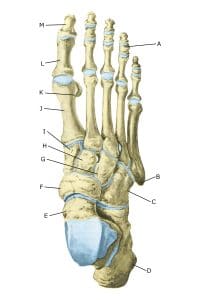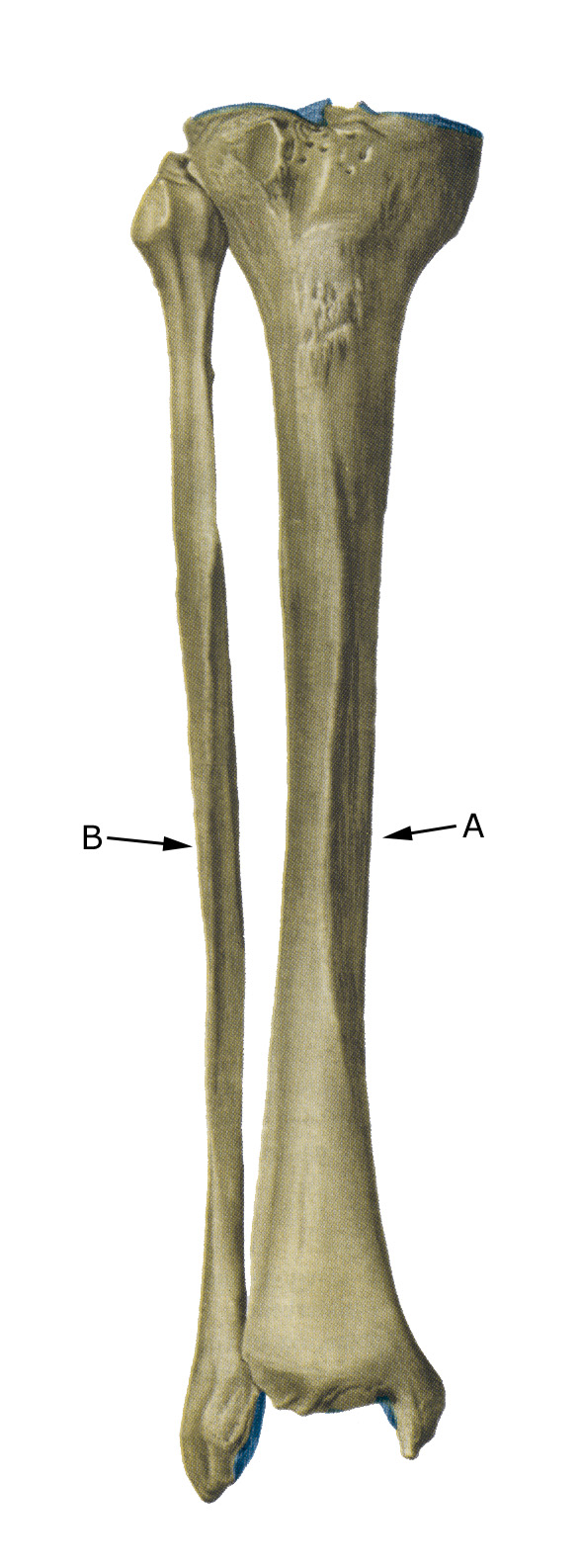Anatomy
The tibia (shin bone) and fibula (fibula) together with the talus (ankle roll bone) form the bones of the ankle joint. The heel bone (calcaneus) and some of the 7 tarsal bones (ossa tarsi) are closely related to the foot joint. In addition, the bones of the foot include 5 metatarsal bones (ossa metatarsi) and the bones of the toes (phalanx).
 The foot from above:
The foot from above:
A. Phalanx media
B. Tuberositas ossis metatarsalis V
C. Os cuboideum
D. Calcaneus
E. Talus
F. Os naviculare
G. Os cuneiforme laterale
H. Os cuneiforme intermedium
I. Os cuneiforme mediale
J. Os metatarsalei
K. Os sesamoideum
L. Phalanx proximalis
M. Phalanx distalis

Shinbone from the front
A. Tibia
B. Fibula
Cause of the problem
Ankle and foot fractures are the most common fractures in sports. A violent impact such as a punch/kick or twist can lead to bone fractures. Often twisting the ankle joint simply causes small pieces of bone to tear where the ligaments attach to the ankle bones (malleoli), but both the inner and outer ankle bones can fracture – see X-ray
and in some cases, the fibula breaks right at the knee. In complicated cases, there are fractures into the articular surfaces and displacement of the fracture surfaces. Ankle fractures are often combined with ligament ruptures.
In principle, all bones in the ankle, heel, metatarsus and forefoot can fracture in a relevant trauma. Fractures of the toe bones after direct trauma are very common.
Symptoms
Acute onset pain that worsens with strain (supporting the foot, walking and running). There is pain on pressure (direct and indirect tenderness).
Examination
Suspected fractures caused by an acute twist or impact/kick to a bone in the ankle/foot should lead to a clinical examination by a relevant professional (possibly hospital) who can assess the need for an X-ray (or MRI or CT scan) and make a correct diagnosis so that treatment can be started as soon as possible.
Treatment
Treatment is entirely dependent on which bones are broken and whether surgery has been performed (Peng H, et al. 2023). In some cases, offloading without bandaging is chosen, while other fractures require bandaging and possibly surgery – see X-ray. Fractures of the 2nd-5th toe can often be treated simply by taping two toes together, while fractures of the big toe with significant displacement are usually treated with surgery. Fractures involving the articular surfaces require special attention, as the risk of permanent discomfort is significantly higher.
Rehabilitation, specific:
Recovery is entirely dependent on the type of fracture and treatment (conservative or surgical). Often it will be possible to maintain cardio and training of all other muscles. General, rehabilitation.
If surgery or bandaging has been performed, rehabilitation guidelines should be included from the treatment centre that take into account the type of injury. As a general rule, foot loading should only be resumed once the pain has subsided.
Complications
If progress is not smooth, you should be reassessed by an appropriate professional to ensure that the fracture is healing as planned.
Especially
As there is a risk of permanent injury, serious injuries should be reported to your insurance company.
